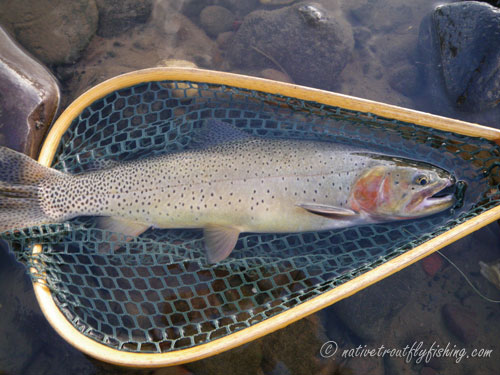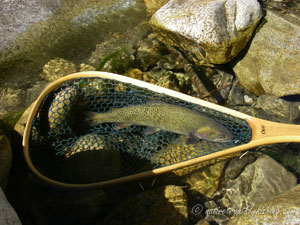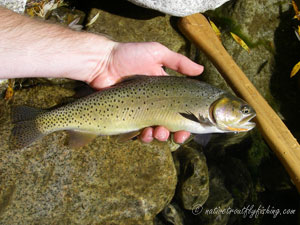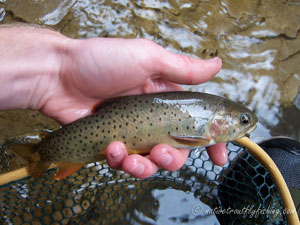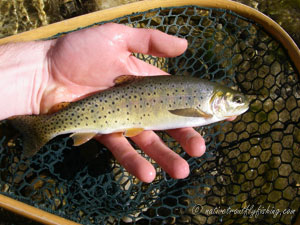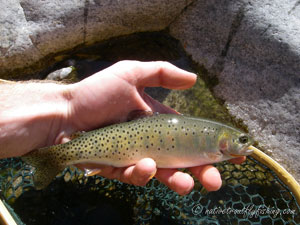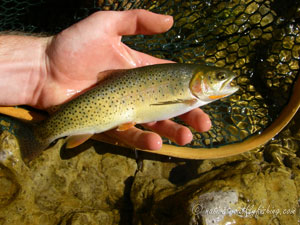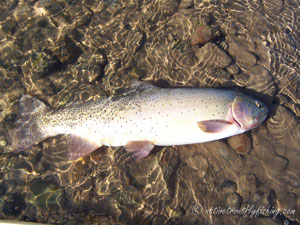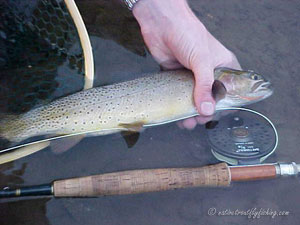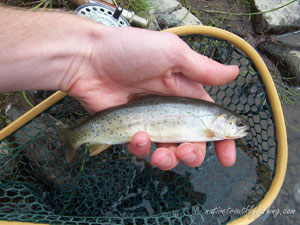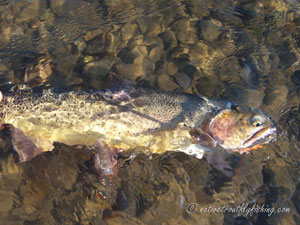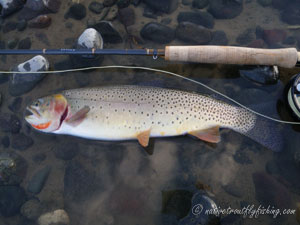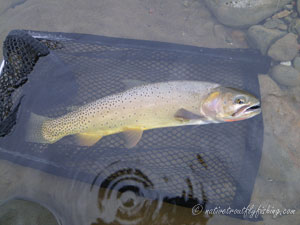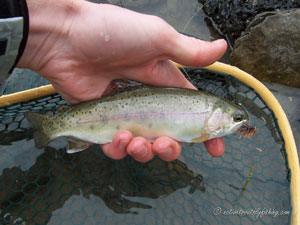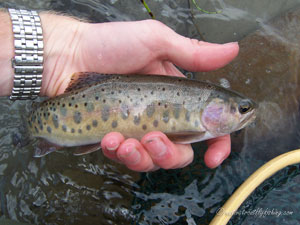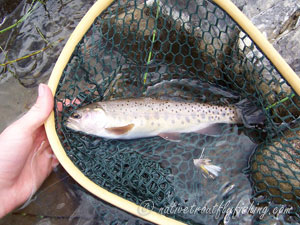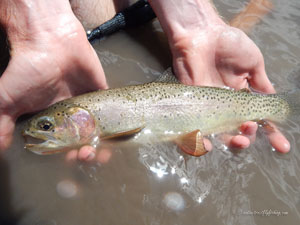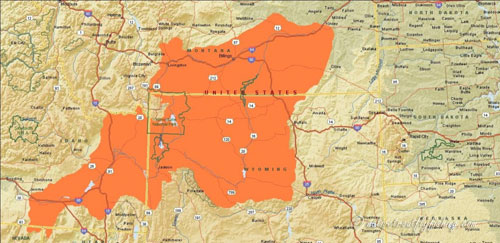Yellowstone Cutthroat
Oncorhynchus virginalis bouvieri
A 16" native fluvial Yellowstone Cutthroat Trout from a stream in Yellowstone National Park.
Introduction
The Yellowstone Cutthroat is native to the Yellowstone and Upper Snake River drainages of Montana, Idaho, Wyoming and a small part of both Utah and Nevada. There is some debate as to how far west their original native range of the Yellowstone extended, as two outlier populations of trout, one from Crab Creek, Washington and one from Waha Lake, Idaho, were originally described as Yellowstone Cutthroat and the type locality for Yellowstone Cutthroat is from the Waha Lake trout (Trotter 2008). However, the spotting pattern of some Clearwater-Eastern Cascades Westslope Cutthroat closely resembles that of the Yellowstone Cutthroat and Columbia Basin Redband often exhibit cutthroat markings under their jaws, so it is quite likely that the native trout of these waterbodies were miss identified as Yellowstone Cutthroat. With both of these outlier populations now extinct there is no way to know for sure which type of trout originally inhabited either of these waters. Oddly enough right in the middle of the native range of the Yellowstone Cutthroat, dwells another form of Cutthroat called the Snake River Finespotted Cutthroat. As their name suggests, these fish have considerably smaller spots than the larger spotted Yellowstone Cutthroat, which are found both upstream and downstream of them (Behnke 2002). While the Snake River Finespotted Cutthroat was classified as a distinct subspecies, recent genetic evidence suggests that it is just a uniquely spotted form of Yellowstone Cutthroat (Campbell et al. 2018, Trotter et al. 2018). Previously the Yellowstone Cutthroat was considered a major subspecies of Cutthroat Trout (Behnke 1992, Behnke 2002), however more recent classification considers it a subspecies of Rocky Mountain Cutthroat Trout (Trotter et al. 2018).
Life History Information
Yellowstone Cutthroat exhibit three life history strategies, stream resident, fluvial (river migrant) and adfluvial (stream to lake migrant). Like all Cutthroat Trout, Yellowstone Cutthroat spawn in the spring and capable of spawning multiple times (iteroparous).
Stream Resident Form
Stream resident populations of Yellowstone Cutthroat are typically found in the upper reaches smaller streams and often represent the most genetically pure populations of Yellowstone Cutthroat remaining today. Fish exhibiting this life history typically grow slowly often only attaining a maximum size of 9 to 10 (23 to 25 cm) and rarely live longer than 3 to 5 years of age (Behnke 2002, Uthe et al. 2016). Stream resident trout are opportunistic feeders with a diet consisting primarily of aquatic and terrestrial insects. However, fish in one population Cutthroat were found to eat a large amount red-osier dogwood berries, which fall into the stream in late summer (Skinner 1985). Spawning typically takes place between April and August depending on elevation and water temperature (Trotter 2008). These Cutthroat typically spawn for the first time at age-2 or age-3, at lengths of 4 to 10 (10 to 25 cm) (Meyer et al. 2003). Stream resident fish often spawn in their home range but move may up or downstream in the natal to spawn, instead of migrating into tributary streams (Gresswell 1995). After emergence, fry may disperse upstream, downstream or remain in the area near the redd (Varley and Gresswell 1988). A genetically unique stream resident population occurs in Sedge Creek in Yellowstone National Park, where the trout are thought to have been isolated for the last 20,000 years due to thermal barriers in the lower watershed (Loudenslager and Kitchin 1979).
Fluvial (River Migratory) Form
The fluvial life history form is common throughout the native range of the Yellowstone Cutthroat, especially in larger watersheds like the Yellowstone and Snake rivers. Fluvial Yellowstone Cutthroat are generally opportunistic feeders primarily feeding on aquatic terrestrial invertebrates. However, in some populations fish may make up a substantial portion of their diet. Fluvial Yellowstone Cutthroat typically reach a maximum size of 20 to 24 (51-61 cm) and can live up to 10 years of age (Meyers et al. 2003, Trotter 2008). However, fluvial Yellowstone Cutthroat can reach even larger sizes and the Idaho state catch and release record caught out of the Snake River was a 31 (79 cm) Cutthroat. Fluvial Yellowstone Cutthroat typically reach maturity at age-4 to age-5 when they are around 12 (30 cm), with males maturing at younger ages than females (Meyer et al. 2003). On the South Fork of the Snake River, the average spawning female is approximately 15 (38 cm) and carries about 1,400 eggs (Trotter 2008). During summer, fluvial Yellowstone Cutthroat typically reside in fairly small home ranges but may move throughout the river system to maximize foraging opportunities. As temperatures drop, these Cutthroat move into overwinter habitat and have been shown to favor runs when water temperatures are above 34° F (1° C), and deep spring-fed off channel pools when water temperatures are below 34° F (1° C) (Harper and Farag 2004). Tributary spawning Yellowstone Cutthroat are generally not known for making long distance spawning migrations, and Cutthroat in the Yellowstone River traveled an average 7 miles (11.4 km) to reach their spawning grounds, although distances of up to 30 miles (51.7 km) were documented (De Rito et al. 2010). Although many populations utilize tributaries as spawning habitat, some fluvial fish are known to spawn in the side channels of larger rivers as well (De Rito 2004). Spawning typically takes places as spring runoff subsides and can range from March through August depending on the location (Trotter 2008). In the Yellowstone River, spawning typically takes place between June and July, with peak spawning occurring during the last two weeks of June (Byorth 1990, De Rito 2004). Similarly, Yellowstone Cutthroat in the Snake River system spawn during June just after spring runoff has subsided (Thurow and King 1994). While Yellowstone Cutthroat are capable of repeat spawning, it is common for fish to skip a year between spawning events (Trotter 2008). Fry typically emerge from the gravel in late summer or early fall, with emergence starting in late July and finishing by mid-August in Yellowstone River tributaries (Byorth 1990, WGFD 2005). Juvenile behavior varies considerably, and, in some populations, fry may move to mainstem rivers shortly after emerging, while in others they may spend between one to three years rearing in their natal stream before migrating to the river (Byorth 1990, Trotter 2008). During their first year juvenile Cutthroat rear in stream margin areas, utilizing the space between cobble to hide in winter, which buffers against cold water temperatures and provides shelter from predators (Griffith and Smith 1993). In some populations to fluvial and adfluvial life histories occur side by side. In these cases, the mechanisms leading to fish adopt a fluvial versus adfluvial life history are still unclear as there does not always appear to be clear separation between the life history types. For example, in the outlet of Yellowstone Lake both fluvial and allacustrine (outlet spawning-lake migrant) Cutthroat are present. These two life histories do not appear to be reproductively isolated, as they both spawn in the same sections of the river and at the same time (Kneading and Boltz 2001).
Adfluvial (Stream to Lake Migratory) Form
The largest and best studied population of adfluvial Yellowstone Cutthroat occurs in Yellowstone Lake. Yellowstone Lake is a large, deep oligotrophic (low nutrient) lake located at 7,733 feet (2,357 m) above sea level. The lake has a short growing season and is typically frozen over from late December until late May Growth is slow in the lake and during their first year, juveniles feed primarily on zooplankton in deep open water (Trotter 2008). However, once they age-2 to age-3, they spend most of their time in foraging the littoral zone (near shore) feeding on aquatic and terrestrial invertebrates (Gresswell 2011). Since the trout of Yellowstone Lake only evolved alongside one other fish species, they do not readily feed on other species of fish. The combination of this and the cold, low nutrient waters, is that the trout grow slowly, attaining maximum size of around 21 (53 cm) and 4 lbs. (1.8 kg) at an age of eight or nine years. In comparison, Henrys Lake in Idaho which is also home to a native adfluvial population of Yellowstone Cutthroat, is shallow and nutrient rich. Even though the Cutthroat still primarily feed on invertebrates and rarely on fish, they grow faster than those in Yellowstone Lake, attaining a maximum size of 24 (61 cm) long and six pounds (2.7 kg), with a lifespan of six or seven years (Behnke 2002). However, Cutthroat up to 11 years old have been caught from the lake and recently a record setting Yellowstone Cutthroat x Rainbow Trout hybrid measuring 36 (91 cm) was caught in the lake (McCarrick et al. 2022). In Heart Lake in Yellowstone National Park, the Cutthroat evolved alongside seven other species of fish and as such are known for being highly piscivorous and can exceed weights of 11 lbs. (5 kg) (Gresswell 1995, Gresswell 2011).
While outlet spawning has been observed in three lakes within the range of the Yellowstone Cutthroat, the majority of Yellowstone Cutthroat spawn in tributaries to the lakes. Adfluvial fish in Yellowstone Lake have been observed spawning in 68 of the 124 tributaries to the lake (Gresswell and Varley 1988). Cutthroat in Yellowstone Lake ascend the tributaries to spawn shortly after the peak of spring runoff, with spawning typically occurring in mid-June, although in warmer south facing streams it may occur in late-May (Gresswell et al. 1997). Adfluvial fish that spawn in the upper Yellowstone River above the lake, have been shown to migrate long distances, traveling an average of 26 miles (42.6 km) upstream to spawn and as far as 41 miles (65.9 km) upstream to spawn (Ertel et al. 2017a). Similar to Pacific Salmon, McCleave and LaBar (1972) showed that the trout of Yellowstone Lake have a homing mechanism and typically return to their natal stream to spawn. Generally, adults only remain in tributaries for 1 to 3 weeks after spawning but have been observed spending several months in larger tributaries and some Cutthroat in Pelican Creek overwinter in the stream prior to returning to Yellowstone Lake the next spring (Gresswell et al. 1994). Adfluvial Yellowstone Cutthroat are capable of spawning multiple times, although mortality appears to be high between spawning events. Of the fish that do successfully spawn a second time, 93% return to spawn the next year, and 7% appear to skip a year between spawning events (Ertel et al. 2017a). Like first time spawners, repeat spawners appear to have relatively strong homing fidelity, with 78% spawning within 2 miles (3 km) of their previous spawning location (Ertel et al. 2017a). Juvenile Cutthroat emerge from the gravel between July and August and like the fluvial life history, there is substantial variation in residence time for juveniles in tributaries. A study in tributary to Yellowstone Lake, Arnica Creek showed that 87.3% of outmigrants in mid-July to mid-August were newly emerged fry, with age-1 and age-2 fish make up the remainder (Benson 1960), while age-1 and age-2 migrants appear to make up a greater proportion of the population Pelican Creek (Gresswell et al. 1994).
Status
While the populations of many other subspecies of Rocky Mountain Cutthroat have diminished to just a fraction of their historical abundance and distribution in the western United States, Yellowstone Cutthroat have continued to hold on across much of its native range. Although Yellowstone Cutthroat are the most abundant and extensively distributed subspecies of Rocky Mountain Cutthroat, they still only inhabit about 43% historical native range (Endicott et al. 2016). Much of the remaining Yellowstone Cutthroat habitat (65%) is on relatively pristine federal or tribal land, with Yellowstone National Park making up the core of their native range (May et al. 2007). A variety of factors have led to the decline of the Yellowstone Cutthroat, such as past over-fishing and habitat loss, but the primary factor impact them has been the introduction of non-native fish. the decline of the Yellowstone Cutthroat, there have been several petitions to list them under the Endangered Species Act, but the United States Fish and Wildlife Service determined that a listing was not warranted in each case (USFWS 2001, USFWS 2006).
As with many inland Cutthroat subspecies, the biggest threat to the Yellowstone Cutthroat today continues to be the introduction of non-native fish. For example, historically Yellowstone Cutthroat were only species of trout in some of the region's most famous rivers, such as the Henry's Fork of the Snake and the Yellowstone River. However, today they have been largely replaced by introduced Brown Trout and Rainbow which favor warmer lower elevation waters, while Brook Trout have become the dominant species in many higher elevation tributary streams. The spread of these introduced species has been widespread and in Idaho about half of the 457 sites sampled for Yellowstone Cutthroat Trout across their native range were found to contain non-native species (Meyer et al. 2006). These non-native trout present a variety of threats to Yellowstone Cutthroat, ranging from competition, predation, and a loss of genetic integrity through hybridization. Both Brook Trout and Brown Trout spawn in the fall, which allows their offspring to hatch earlier than those of the spring spawning Cutthroat. This has given both species a competitive edge over Yellowstone Cutthroat at a critical juvenile life stage when resources are often limited. The effectiveness of Brook Trout at replacing Yellowstone Cutthroat populations is illustrated by a survey of the Henrys Fork drainage which showed that 50% of the sampled streams contained only Brook Trout, 45.5% held only Yellowstone Cutthroat and 4.5% of sites contained both species (De Rito and Emery-Miller 2006). In streams harboring both Yellowstone Cutthroat and Brown Trout populations, the two species a have high level of diet overlap throughout the summer and fall months, which has resulted in significantly lower growth rates and a pronounced decline in survival for Yellowstone Cutthroat, when compared to populations where Yellowstone Cutthroat are the sole trout species (Al-Chokhachy and Sepulveda 2019). Additionally, as Brown Trout grow, they become increasingly piscivorous and thus present a predation risk to juvenile Yellowstone Cutthroat. The risk posed by Brown Trout seems to be increasing with climate change as Brown Trout are invading higher elevation streams and becoming increasing dominant in many watersheds (Al-Chokhachy and Sepulveda 2019).
While Brook and Brown Trout are problematic, introduced Rainbow Trout likely present the greatest threat to stream dwelling Yellowstone Cutthroat Trout. As Rainbow Trout and Yellowstone Cutthroat are both relatively closely related spring spawning species of Pacific Trout, they are capable of interbreeding. This has resulted in hybridization in many populations of Yellowstone and a loss of genetic integrity for the subspecies. As of the last status update, pure (unhybridized) populations are only found in 23% of the current distribution of the subspecies (Gresswell 2011). A study on the South Fork of the Snake River in Idaho showed that while the distribution of hybrids increased significantly from the 1980s to early 2000s, it has declined again in recent years (Meyers et al. 2014). This may be in part to fishing regulations in the basin that promote harvesting Rainbow Trout and releasing Yellowstone Cutthroat. However, the distribution of hybrids in the South Fork Snake River appears to be strongly linked with the distance from the original stocking sites, suggesting that these locations continue to be hybridization hotspots (Gunnell et al. 2008). Unfortunately, Yellowstone Cutthroat on the South Fork Snake River still appear to be losing ground, as their populations are currently below replacement, while Rainbow, Brook and Brown Trout populations are still increasing, showing that Yellowstone Cutthroat continue to be threatened by these introduced species.
A major factor that can influence the magnitude of hybridization are environmental variables. For example, cooler higher elevation sites often to have a higher likelihood of harboring pure populations of Cutthroat and are less likely to be invaded by Rainbow and Brown Trout. Additionally, differences in life history allowed some populations, such as fluvial fish in the Yellowstone River to maintain their genetic integrity despite the presence of Rainbow Trout in. According to De Rito (2004), the major mechanism for this is a difference between the spawning time of the Cutthroat and Rainbow Trout. While both species utilize the same habitat for spawning, Rainbow Trout typically spawn prior to or during spring runoff in April to May, while Yellowstone Cutthroat generally spawn after spring runoff in June to July, which has resulting five to nine weeks difference in the start date of spawning between the two species (De Rito et al. 2010). However, other sources report that this reproductive isolation has begun to break down in recent years and the Rainbow Trout are becoming increasingly dominant throughout the drainage, especially in the lower river (Trotter 2008). In other locations, such as the Lamar River drainage in Yellowstone National Park, environmental factors do not appear hindering hybridization, and like the South Fork Snake River, hybrid frequencies are strongly tied to original stocking sites (Heim et al. 2020a). In the case the Lamar drainage Buffalo Fork Creek is acting a hotspot for hybridization as Rainbow Trout completely replaced Cutthroat in the drainage and are now dispersing throughout the Lamar River. Unlike the South Fork Snake River where there has been a reduction in Rainbow Trout and hybrid distribution in recent years, in the Lamar drainage Rainbow Trout and hybrids are continuing to push further upstream and the frequency of hybridization is also increasing (Ertel et al. 2017b). Several strategies are being used in the Lamar drainage to combat the spread of Rainbow Trout in the basin. First, starting in 2014 the National Park Service is now requiring anglers to harvest any Rainbow Trout encountered in the upper watershed and they are now also exploring the retention of hybrids as well to manage the population (Ertel et al. 2017b). While the effectiveness of this strategy relies on angler buy-in, data suggest it could be highly effective as each trout in the road accessible part of the Lamar River is caught approximately five times per year (Heim et al. 2020b). Another approach that is being pursued is the construction fish passage barriers. These barriers do their job of isolating Cutthroat populations, but in the process also result in a loss of genetic connectivity between Cutthroat populations and remove the ability of fish to express a fluvial life history and as such need to be used carefully. The final piece of the management strategy for the Lamar basin is the to remove the Rainbow Trout population in Buffalo Fork Creek and reintroduce Yellowstone Cutthroat to the stream. This project started in August of 2022 and is planned to run for the next five years and is likely the most important piece of the strategy as it will remove the primary source population of Rainbow Trout invading the basin (Heim et al. 2020a). It can be hoped that together these strategies with start to reverse the trajectory that the Lamar drainage is on, and that Yellowstone Cutthroat will be able to continue to thrive in the watershed.
Today adfluvial Yellowstone Cutthroat occupy far more waterbodies than they historically did. Historically, Yellowstone Cutthroat are believed to have occupied 61 lakes across their native range, compared to the 223 lakes with over 3.6 times the surface area of their historic distribution (Gresswell 2011, Endicott et al. 2016). Of their 61 native lakes, Yellowstone Lake is by far the largest and makes up 78% of the surface area of the lake habitat that these trout historically occupied (Gresswell 2011). As such, no discussion on the status of Yellowstone Cutthroat would be complete without covering the problems now facing the trout of Yellowstone Lake. It is believed that Yellowstone Lake historically supported 7.5 to 10 million trout, which were an essential component of the ecosystem, providing prey for numerous other species, such as Bald Eagles, Osprey, Pelicans, River Otters, and Grizzly Bears (Stapp and Hayward 2002a, Koel et al. 2005, Crait and Ben-David 2006, Trotter 2008). However, in 1994 illegally introduced Lake Trout were discovered in Yellowstone Lake and now pose a serious threat to the lakes Cutthroat.
Lake trout are highly piscivorous predators and depending on the size of the Lake Trout population are expected to increase juvenile Cutthroat mortality by 13% to 67% (Stapp and Hayward 2002a). If left uncontrolled, this predation was expected to reduce the Cutthroat population by 60% to 90% over the next 20 to 100 years (Kaeding et al. 1996; Stapp and Hayward 2002b). As if the Lake Trout didn't already present a big enough threat, in 1998 whirling disease was discovered in the lake and is also expected to have an impact on the Cutthroat population (Trotter 2008). The effects of Lake Trout were clearly on the lake's Cutthroat population have been clearly seen in the lakes tributaries and between 1999 and 2004 the number of spawners in Bridge and Clear Creeks declined 90% (Koel et al. 2005). The National Park Service has adopted a mandatory catch and kill policy for Lake Trout in Yellowstone Lake and since 1995, has been gill netting the Lake Trout in known spawning areas to suppress the Lake Trout population. By 2007 the National Park Service had netted around 272,000 Lake Trout, with 74,000 fish caught in 2007 alone (NPS 2008). However, trends indicated that the Lake Trout population was still growing despite the suppression efforts. This resulted in the National Park Service reassessing the suppression effort and greatly increasing the netting program. As a result, 3.4 million Lake Trout have now been removed since the start of the program and the Lake Trout population is starting to decline. Between 2012 and 2019, the biomass of adults Lake Trout in the lake was cut in half and resulted in a 79% reduction in mature Lake Trout (Koel et al. 2020). However, in response the recruitment of age-2 Lake Trout appears to have increased meaning that the overall population has only declined by about 27%. While Cutthroat abundance in Yellowstone Lake remains well below the conservation goals, there are signs of a response to the Lake Trout suppression efforts as the weights of Cutthroat have doubled and the number of large Cutthroat has increased in recent years. However, there is still a long way to go and unless managers can find a way to eradicate the Lake Trout population, suppression efforts will have to remain in effect into the future.
While there are certainly challenges ahead for the Yellowstone Cutthroat, their distribution has remained relatively stable at approximately 7,500 miles (12,070 km) of stream habitat over the last decade (Varley and Gresswell 1988; May et al. 2003, Gresswell 2011, Endicott et al. 2016). Improved management practices have certainly played a role in stemming the decline of the Yellowstone Cutthroat, with conservation of native fish being prioritized in many locations. Additionally, the progress being made on Yellowstone Lake is heartening, but still has a long way to go to return the lakes Cutthroat population to its former abundance. However, non-native trout are firmly established in many waters and are projected to expand their range with climate change. As such, it will be important for managers, conservation groups and anglers to continue do their part to reduce the risk presented by introduced trout populations and prioritize maintaining the high-quality cold-water habitat that Yellowstone Cutthroat depend on.
Description
The coloration of the Yellowstone Cutthroat is generally less intense than that of other inland forms of Cutthroat (Behnke 2002). Yellowstone Cutthroat are typically a brownish-olive color on the back, which transitions to a yellowish-brown, golden-olive, or bronze color on the sides, which becomes paler near the belly. The colors on belly of some mature fish may become a brilliant golden-yellow. Additionally, some individuals may display a rose color along the lateral line and on the gill plates. The coloration of the lower fins ranges from a bright orange to a peach or rose color. There is considerable variation in the spotting pattern of Yellowstone Cutthroat, but generally the spots tend to be fairly large, round and concentrated toward the posterior region of the fish. These spots are found above and below the lateral line, as well as on the dorsal and caudal fins. However, adfluvial fish from Yellowstone Lake are known for having spots spread across their entire body (Trotter 2008). Juveniles exhibit 9-12 oval shaped parr marks on their sides, which typically fade away on mature fish. Like other Cutthroat, these fish have a red or orange Cutthroat mark below the lower jaw.
Stream Resident Form
Click on images to view a larger picture
Fluvial Form
Hybrids
Native Range
Above: A map of the native range of the Yellowstone Cutthroat Trout. Data Source: Behnke (2002) and Trotter (2008). Below: A map of the native range of the Yellowstone and Snake River Finespotted Cutthroat Trout.
References
Al-Chokhachy, R. and A.J. Sepulveda. 2019. Impacts of nonnative Brown Trout on Yellowstone Cutthroat Trout in a tributary stream. North American Journal of Fisheries Management 39: 17-28.
Behnke, R. J. 1992. Native trout of western North America. American Fisheries Society Monograph 6. American Fisheries Society, Bethesda, Maryland.
Behnke, R. 2002. Trout and Salmon of North America. Chanticleer Press, New York.
Benson, N.G. 1960. Factors influencing production of immature cutthroat in Arnica Creek, Yellowstone Park. Transactions of the American Fisheries Society 89: 168-175.
Byorth, P.A. 1990. An evaluation of Yellowstone cutthroat trout production in three tributaries of Yellowstone River, Montana. Masters Thesis. Montana State University. Bozeman, Montana.
Campbell, M.R., E.R. Keeley, C.C. Kozfkay, J.L. Loxterman, R.P. Evans and D.K. Shiozawa. 2018. Describing and preserving the diversity of Cutthroat Trout in the Yellowstone River, Snake River, and Bonneville Basin. Pages 303-321 in Trotter P, Bisson P, Schultz L, Roper B (editors). Cutthroat Trout: Evolutionary Biology and Taxonomy. Special Publication 36, American Fisheries Society, Bethesda, Maryland.
Crait, J.R. and M. Ben-David. 2006. River otters in Yellowstone Lake depend on a declining Cutthroat Trout population. Journal of Mammalogy 87(3): 485-494.
De Rito, J.N. 2004. Assessment of reproductive isolation between Yellowstone cutthroat and rainbow trout in the Yellowstone River, Montana. Master's thesis, Montana State University, Bozeman.
De Rito, J.N. A.M. Emery-Miller. 2006. Yellowstone cutthroat trout survey and population assessment - 2005. Henry’s Fork Foundation. Ashton, Idaho.
De Rito, J.N., A.V. Zale and B.B. Shepard. 2010. Temporal reproductive separation of fluvial Yellowstone Cutthroat Trout from Rainbow Trout and hybrids in the Yellowstone River. North American Journal of Fisheries Management 30: 866-886.
Endicott, C., L. Nelson, S. Opitz, A. Peterson, J. Burckhardt, S. Yekel, D. Garren, T.M. Koel and B. Shepard. 2016. Range-wide status assessment for Yellowstone Cutthroat Trout (Oncorhynchus clarkii bouvieri): 2012. Prepared for: Yellowstone Cutthroat Trout Interagency Coordination Group. Montana Fish, Wildlife & Parks. Helena, Montana.
Ertel, B.D., T.E. McMahon, T.M. Koel, R.E. Gresswell and J.C. Burckhardt. 2017a. Life history migrations of adult Yellowstone Cutthroat Trout in the upper Yellowstone River. North American Journal of Fisheries Management 37(4): 743-755. DOI: 10.1080/02755947.2017.1313793
Ertel, B.D., K.C. Heim, J.L. Arnold, C.R. Detjens and T.M. Koel. 2017b. Preservation of native cutthroat trout in Northern Yellowstone. Yellowstone Science 25(1): 35-41.
Gresswell, R.E. and Varley, J.D. 1988. Effects of a century of human influences on the cutthroat trout of Yellowstone Lake. American Fisheries Society Symposium 4: 45-52.
Gresswell, R.E., W.J. Liss and G.L. Larson. 1994. Life-history organization of Yellowstone cutthroat trout (Oncorhynchus clarki bouvieri) in Yellowstone Lake. Canadian Journal of Fisheries and Aquatic Sciences 51(Suppl. I ): 298-309.
Gresswell, R.E. 1995. Yellowstone cutthroat trout. Pages 36-54 in . Young, M.K. (Editor). Conservation assessment for inland Cutthroat Trout. General Technical Report. RM-GTR-256. United States Forest Service, Rocky Mountain Forest and Range Experiment Station. Fort Collins, Colorado.
Gresswell, R.E. 2011. Biology, status, and management of the Yellowstone Cutthroat Trout. North American Journal of Fisheries Management 31: 782-812.
Griffith, J.S. and R.W. Smith. 1993. Use of winter concealment cover by juvenile cutthroat and brown trout in the South Fork of the Snake River, Idaho. North American Journal of Fisheries Management 13: 823-830.
Gunnell, K., M.K. Tada, F.A. Hawthorne, E.R. Keeley and M.B. Ptacek. 2008. Geographic patterns of introgressive hybridization between native Yellowstone cutthroat trout (Oncorhynchus clarkii bouvieri) and introduced rainbow trout (O. mykiss) in the South Fork of the Snake River watershed, Idaho. Conservation Genetics 9:49-64.
Harper, D.D. and A.M. Farag. 2004. Winter habitat use by cutthroat trout in the Snake River near Jackson, Wyoming. Transactions of the American Fisheries Society 133:1525.
Heim, K.C., T.E. McMahon, B.D. Ertel and T.M. Koel. 2020a. Abiotic conditions are unlikely to mediate hybridization between invasive rainbow trout and native Yellowstone cutthroat trout in a high-elevation metapopulation. Canadian Journal of Fisheries and Aquatic Sciences 77: 1433-1455. dx.doi.org/10.1139/cjfas-2019-0317
Heim, K.C., T.E. McMahon, B.D. Ertel and T.M. Koel. 2020b. Leveraging public harvest to reduce invasive hybridization in Yellowstone National Park: field identification and harvest of cutthroat x rainbow trout hybrids. Bio Invasions 22: 2685-2698. https://doi.org/10.1007/s10530-020-02280-y
Kaeding, L.R., Boltz, G.D. and Carty, D.G. 1996. Lake trout discovered in Yellowstone Lake threaten native cutthroat trout. Fisheries 21(3): 16-20.
Kaeding, L.R. and Boltz, G.D. 2001. Spatial and temporal relations between fluvial and allacustrine Yellowstone cutthroat trout Oncorhynchus clarki bouvieri, spawning the Yellowstone River, outlet stream of Yellowstone Lake. Environmental Biology of Fishes 61: 395-406.
Koel, T.M., Bigelow, P.E., Doepke, P.D., Ertel, B.D. and Mahony, D.L. 2005. Nonnative lake trout result in Yellowstone cutthroat decline and impacts to bears and anglers. Fisheries 30(11): 10-19.
Loudenslager, E.J. and R.M. Kitchin. 1979. Genetic similarity of two forms of cutthroat trout, Salmo clarki, in Wyoming. Copeia 4(28): 673-678.
May, B.E., Urie, W., Shepard, B.B., Yundt, S., Corsi, C., McDonald, K., Snyder, B., Yekel, S. and Walker, K. 2003. Range-wide status of Yellowstone cutthroat trout (Oncorhynchus clarki bouvieri): 2001. YCT Multi-state Assessment
May, B.E., S.E. Albeke and T. Horton. 2007. Range-wide status of Yellowstone cutthroat trout (Oncorhynchus clarkii bouvieri): 2006. Yellowstone Cutthroat Trout Interagency Coordination Group, Bozeman, Montana, USA.
McCleave, J.D. and LaBar, G.W. 1972. Further ultrasonic tracking and tagging studies of homing cutthroat trout (Salmo clarki) in Yellowstone Lake. Transactions of the American Fisheries Society 1: 44-54.
Meyer, K.A., D.J. Schill, F.S. Elle and J.A. Lamansky Jr. 2003. Reproductive demographics and factors that influence length at sexual maturity of Yellowstone cutthroat trout in Idaho. Transactions of the American Fisheries Society 132: 183195.
Meyer, K.A., Schill, D.J., Lamansky, J.A., Campbell, M.R. and Kozfkay, C.C. 2006. Status of Yellowstone cutthroat in Idaho. Transactions of the American Fisheries Society 135: 1329-1347.
Meyer, K.A., E.I. Larson, C.L. Sullivan and B. High. 2014. Trends in the distribution and abundance of Yellowstone Cutthroat Trout and nonnative trout in Idaho. Journal of Wildlife Management 5(2): 227-242
National Park Service. Yellowstone National Park (2008). Preservation of Yellowstone Lake cutthroat trout. Retrieved March 26, 2009, from http://www.nps.gov/yell/planyourvisit/upload/fishar9-18.pdf
Skinner, W.D., 1985. Size selection of food by cutthroat trout (Salmo clarki) in an Idaho stream. Great Basin Naturalist 45:327-331.
Stapp, P. and G.D. Hayward. 2002a. Estimates of predator consumption of Yellowstone Cutthroat Trout (Oncorhychus clarki bouvieri) in Yellowstone Lake. Journal of Freshwater Ecology 17(2): 319-329. DOI: 10.1080/02705060.2002.9663900
Stapp, P. and Hayward, G.D. 2002b. Effects of an introduced piscivore on native trout: insights from a demographic model. Biological Invasions 4: 299-316.
Thurow, R.F. and King, J.G. 1994. Attributes of Yellowstone cutthroat trout redds in a tributary of the Snake River, Idaho. Transactions of the American Fisheries Society 123: 37-50.
Trotter, P. 2008. Cutthroat: Native Trout of the West. Second Edition. University of California Press, Berkley, CA.
Trotter, P., P. Bisson, B. Roper, L. Schultz, C. Ferraris, G.R. Smith and R.F. Stearley. 2018. A special workshop on the taxonomy and evolutionary biology of cutthroat trout. Pages 1-31 in Trotter P, Bisson P, Schultz L, Roper B (editors). Cutthroat Trout: Evolutionary Biology and Taxonomy. Special Publication 36, American Fisheries Society, Bethesda, Maryland.
USFWS (United State Fish and Wildlife Service). 2001. Endangered and threatened wildlife and 90-day finding for a petition to list the Yellowstone Cutthroat Trout as threatened. Federal Register 63:11244. February 23, 2001.
USFWS (United State Fish and Wildlife Service). 2006. Status review: Yellowstone Cutthroat Oncorhynchus clarkii bouvieri. United States Fish and Wildlife Service. 122pp.
Uthe, P., R. Al-Chokhachy, A.V. Zale, B.B. Shepard, T.E. McMahon and T. Stephens. 2016. Life history characteristics and vital rates of Yellowstone Cutthroat Trout in two headwater basins. North American Journal of Fisheries Management 36: 1240-1253. DOI: 10.1080/02755947.2016.1206643
Varley, J.D. and Gresswell, R.E. 1988. Ecology, status and management of the Yellowstone cutthroat trout. American Fisheries Society Symposium 4: 13-24.
WGFD. 2005. Comprehensive wildlife conservation strategy for Wyoming: Yellowstone cutthroat (Oncorhynchus clarki bouvieri) status. Wyoming Game and Fish Department, Cheyenne, WY.
Contact
Feel free to contact me if you have any questions or comments
Yellowstone Cutthroat Trout Links
My Yellowstone Cutthroat Trips
Idaho Department of Fish and Game - Yellowstone Cutthroat Trout
Montana Fish, Wildlife and Parks - Yellowstone Cutthroat Trout
Yellowstone National Park - Yellowstone Cutthroat
Custer Gallatin National Forests
Bighorn Panhandle National Forests
Caribou-Targhee National Forest
Western Native Trout Initiative - Yellowstone Cutthroat Trout
Native Trout Links
California Heritage Trout Challenge
Truchas Mexicanas' - Native Trout of Mexico
Balkan Trout Restoration Group
Trout and Seasons of the Mountain Village - About Japanese Trout
Fly Fishing Blogs
Dave B's Blog: Fly Fishing for Native Trout
The Search for Native Salmonids
Conservation Links
Western Native Trout Initiative
Fly Fishing Links
Fishing Art Links
Americanfishes.com - Joseph R. Tomelleri
